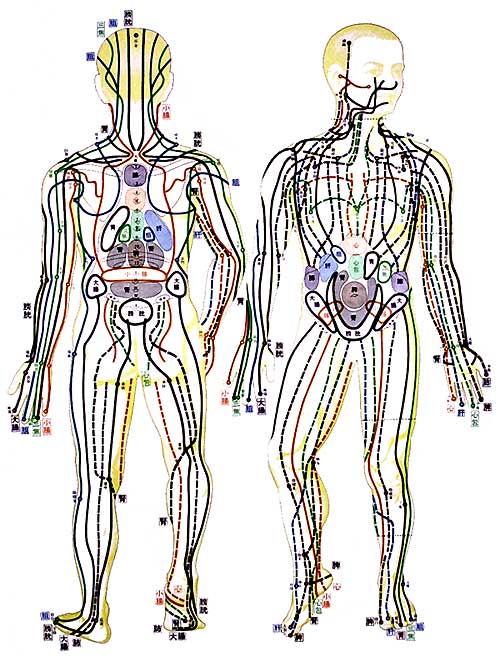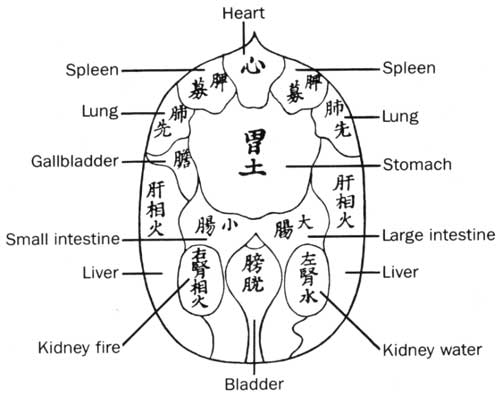Return to ITM Online
Zen Shiatsu
The Legacy of Shizuto Masunaga
by Subhuti Dharmananda, Ph.D., Director, Institute for Traditional Medicine, Portland, Oregon
Shiatsu refers generally to a Japanese pressure therapy used to relieve a variety of problems including back pain, neck and shoulder problems, stress, insomnia, digestive problems, and fatigue. It is based on traditional Chinese medicine techniques, particularly massage therapy that has been recommended since ancient tmes, with certain Japanese innovations. Shiatsu acquired its name with the publication of Tenpaku Tamai's book Shiatsu Ho (Shiatsu Method) in 1919. As a technique separate from other manual therapies, such as Anma (which had been developed in Japan during the 17th century), shiatsu was officially recognized by the Japanese government with a series of laws passed during the period 1955-1964. Its recognition and spread resulted mainly from the efforts of Tokujiro Namikoshi, the founder of modern shiatsu (sometimes called Namikoshi Shiatsu). Namikoshi was author of the book Do It Yourself-3 Minute Shiatsu, which became a best seller; he appeared on television to promote his technique, and used the catch phrase: "All you have to do is press." At that time, finger-pressure was the primary technique of shiatsu.
Zen is one of the sects of Buddhism; it involves training the mind through meditation. The fundamental purpose of Zen is to achieve total enlightenment through the discovery of one's basic nature. Its principles and approaches can be applied to numerous human endeavors. Many aspects of Japanese culture have been influenced by Zen, including archery, aikido, judo and other martial arts, gardening and architecture, tea ceremony, calligraphy, and haiku (Japanese poetry). In this case, it is applied to massage therapy.
Zen Shiatsu was established by a Shizuto Masunaga (1925-1981; see Figure 1), who was born into a family of Shiatsu practitioners. After studying psychology, he decided to pursue shiatsu as well. While reading the classic medical texts, he investigated the practical clinical aspects of shiatsu. Masunaga became a professor of psychology at Tokyo University and, at the same time, he taught psychology at the Japan Shiatsu School. During the late 1970s, one of his new students, Wataru Ohashi, brought Masunaga to the United States, where he provided some teachings in New York and San Francisco. Masunaga then wrote two books about his theoretical framework for Zen Shiatsu and its practical applications, including Zen Shiatsu: How to Harmonize Yin and Yang for Better Health (written with the help of Ohashi; see Figure 2), and Meridian Exercises, which described yoga-like exercises for self-help in maintaining internal balance and good circulation.
Zen Shiatsu is a form of bodywork administered by thumbs, fingers, palms and elbows, feet and knees. It depends for its success on a meditative activity of the practitioner, aimed especially at detecting the body responses to the treatment, which influences the subsequent treatment step by step. Pressure is applied to all parts of the body along specific pathways (meridians). These are essentially the same meridians that are used in traditional Chinese medicine for acupuncture, though modified and extended by Masunaga (so they are sometimes called Masunaga Meridians; see Figures 3-6). It is understood that this technique stimulates the natural healing powers of the body, wherefore symptoms of disease lessen and vitality is regained.
The professional Zen Shiatsu therapist is trained to feel the body's condition, particularly the circulation, by his/her hands in order to find the imbalanced areas in the body. By skillfully stimulating the imbalanced meridians, the therapist attempts to restore the balanced flow. From the Western point of view, shiatsu works directly to calm the autonomic nervous system, which has the effect of calming nervous distress and increasing resistance to stress. By helping with blood and lymph circulation in the body, shiatsu helps to maintain and improve muscle tone and healthy internal organ functions. It is believed that shiatsu can also strengthen the immune system. Regular and consistent shiatsu treatments can become an important aspect of preventive health care as well as treatment for existing symptoms.
Zen Shiatsu is ideally performed while the recipient lies on a futon on the floor, allowing the practitioner access from all sides and the ability to apply pressure using body weight (as opposed to pushing just with finger pressure, as may be done with other shiatsu techniques; see Figure 7). The shiatsu recipient should be dressed comfortably with light clothing. No massage oils or lotions are used or needed because the practitioner does not slide along the body surface, but gives a series of presses along the pathways.
BASIC CONCEPTS
Consistent with the basic concepts of traditional Chinese medicine, Zen Shiatsu is grounded in the theory that health problems are attributed to, or at least involve:
- imbalances in yin and yang;
- disharmonies between the internal organs; and
- blockages to the circulation of ki (in Chinese: qi; in English: chi) through the meridians.
The unique features of Zen Shiatsu, compared to traditional Chinese medicine techniques such as acupuncture or other shiatsu techniques, are these:
- For diagnosis, abdominal palpation is the primary technique used. Abdominal diagnosis (in Japan: hara diagnosis) is an ancient Chinese technique that had been largely abandoned in China, but became important in the practice of Kampo (the Japanese practice of Chinese medicine) around the beginning of the 18th century. Abdominal diagnosis is used in Japan for herbal medicine prescribing, acupuncture, and Zen Shiatsu. The diagnosis is primarily aimed at determining whether each meridian is relatively empty (Japanese: kyo, Chinese: xu) or relatively full (Japanese: jitsu; Chinese: shi). At the end of the treatment, the abdominal diagnosis is performed again to ascertain changes (improvements) that have occurred.
- Pressure is applied at intervals along the meridians that were described by Masunaga. He presented 12 meridians, corresponding to the 12 basic organ-affiliated meridians of the Chinese system. The meridian pathways are similar to, but not the same as, the Chinese ones; the main difference being an extension of each meridian to range from legs to arms, passing through the associated diagnostic region of the abdomen.
- The treatment involves brief contact with each point, in a somewhat rhythmic pattern as a portion of a meridian is traced. The contact is with fairly strong pressure that is applied using the movement of the practitioners body, fingers, elbows, and other parts of the body.
- To attain the proper combination of pressure and movement along the meridian, the practitioner may move frequently around the recipient's body and may even move the recipient (who is instructed to remain passive), such as lifting the head or arms. The actions may include turning or bending the recipient's body parts with the purposes of gaining access to essential points, stretching the meridians, and using gravity or leverage to attain the needed pressure at certain points. The therapy does not focus on one part of the body, even if the health problem is localized; the whole body becomes involved.
- The practitioner works within a meditative state, focusing on the responses of the recipient so as to properly direct the therapy, as opposed to focusing on selection of pressure points by a theoretical system. To develop this condition of heightened awareness and clear intention, the practitioner practices meditation regularly.
Because of its connection to traditional Chinese medicine, Zen Shiatsu serves as an excellent adjunct to acupuncture therapy as well as Chinese or Japanese herb prescribing, fitting well with the theoretical framework. Further, it serves as a complementary therapy for Western methods of manipulation, including chiropractic or standard massage (e.g., Swedish style), providing an entirely different stimulus to the body.
Although Masunaga's Zen Shiatsu is considered essential reading for practitioners, the main textbook of Zen Shiatsu used today is Shiatsu Theory and Practice by Carola Beresford-Cooke (first published 1996; revised edition 2002). She has outlined five basic principles of Zen Shiatsu as follows:
- Relax. The practitioner must be in a comfortable physical and mental condition to convey comfort to the recipient; the arms, hands, neck, and shoulders must be relaxed, not tensed, to give the proper treatment and to perceive the recipient responses.
- Use penetration rather than pressure. It is understood that the body has spots (called "tsubo") that can receive the pressing by the practitioner; the muscle gives way to the penetrating force to let it enter, rather than being pushed away by pressure. The result is an entirely different experience than mere finger-pressing, and requires that the practitioner have the correct body position in relation to the recipient and be mindful of the technique being used.
- Perpendicular penetration without side-to-side motion. Unlike many massage techniques where movement across the surface is emphasized, Zen Shiatsu involves penetration at each point, perpendicular to the body surface. Although there are a few exceptions, the treatment does not involve rotation, back-and-forth, or wiggling movements of the hands, but simple direct inward-directed movement.
- Two handed connectedness. The Zen Shiatsu practitioner maintains two hands on the recipient's body; one hand may be still and holding a part of the body in position, while the other is active, penetrating points on the meridians. The practitioner is advised to give attention to the role of both hands, not just the more active one.
- Meridian continuity. The focus of the therapy is to treat an entire meridian, not just individual points or regions. This is based on the theory that the imbalances to be addressed are based in the meridians, which require a free flow of ki throughout.

Figure 1. Shizuto Masunaga (1925-1981).
| 
Figure 2. Masunaga's primary text: Zen Shiatsu.
|

Figure 3. The Meridians Of Masunaga's Zen Shiatsu.
|

Figure 4. Masunaga's Meridians at the Head.
|

Figure 5. Hara diagnosis chart based on Mubunsai's text of 1685.
| 
Figure 6. A modern interpretation of a Hara diagnosis chart;
a key to the abdominal diagnosis chart on the right is available at:
http://www.yogawelt.com/haradiagnosis.html
|

Figure 7.
Demonstration of Modified Zen Shiatsu at the London College of Shiatsu
The style used at this college is from Takeo Suzuki who worked with
Masunaga and taught Shiatsu at the Iokai Center before starting his
own school in Tokyo. Suzuki further refined and developed the work
of Masunaga for his own unique style.
|
December 2002






